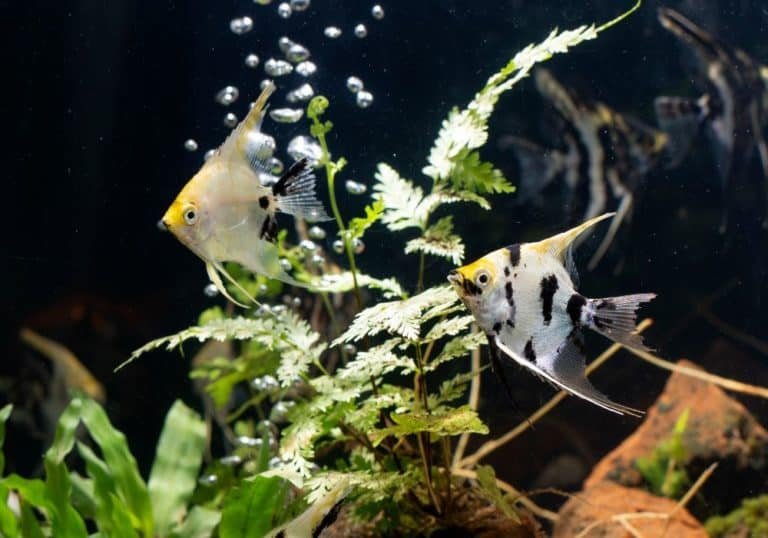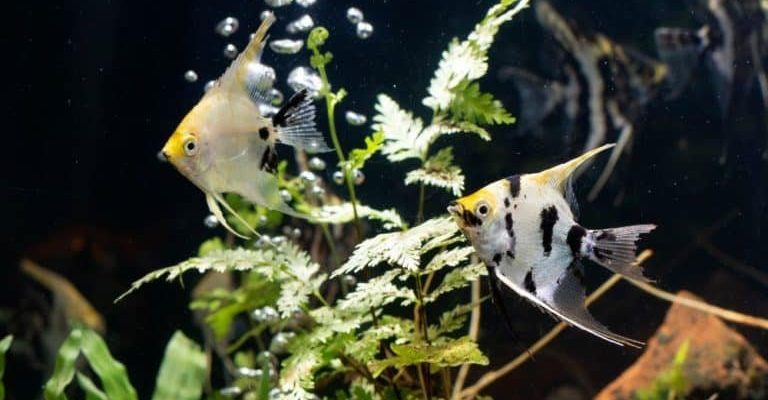
Feeding angelfish is about more than just tossing in some flakes and calling it a day. Much like us, they need a mix of nutrients to thrive. Think of their diet like a well-rounded meal: protein for strong muscles, veggies for fiber, and even some treats from time to time. Plus, understanding angelfish feeding habits can help you create a feeding schedule that suits their needs and keeps them in tip-top shape. Now, let’s break down what’s on the menu for your finned friends!
Understanding Angelfish Diet
Angelfish are omnivores, which means they enjoy a mixture of both plant and animal-based foods. In the wild, they munch on small insects, crustaceans, and various plant matter. To replicate this in your home aquarium, you want to offer a variety of foods. A balanced diet plays a huge role in promoting their health and vibrant colors.
To make it easier, you can categorize angelfish food into three main groups:
- Flake Foods: These are the staples and often contain a mix of proteins and vitamins.
- Pellets: These can sink or float, depending on the type. They’re great for providing a more concentrated form of nutrition.
- Live or Frozen Foods: Think brine shrimp, bloodworms, or even daphnia. These offer a protein boost and encourage natural hunting behaviors.
Keeping a diverse menu not only satisfies their nutritional needs but also keeps them mentally stimulated. It’s like having a buffet daily!
Feeding Schedule for Angelfish
Creating a feeding schedule is essential for angelfish—they thrive on routine. Generally, you want to feed your angelfish two to three times a day, but the key is not to overfeed. Imagine your fish as small meal-prepping pros; they don’t need a giant feast at every meal, just consistent, smaller portions.
Here’s a simple feeding schedule you might consider:
- Morning: Start the day with high-quality flakes or pellets.
- Afternoon: Offer some frozen or live food for a protein boost.
- Evening: Finish off with greens—a small amount of blanched spinach or spirulina is perfect.
This balanced approach keeps their energy levels up and encourages healthy growth. Remember, some fish keepers even like to mix things up on weekends with a “fish treat day” featuring favorite foods!
Best Foods for Angelfish
Now that you’ve got a feeding schedule nailed down, let’s talk specifics about the best foods. Not all fish foods are created equal, and choosing high-quality options can make a world of difference for your angelfish.
1. High-Quality Flake Food: Look for brands that list whole fish or fish meal as the first ingredient. This ensures they’re getting enough protein. Some popular brands include Hikari and Tetra.
2. Pellets: Sinking pellets can be particularly beneficial for angelfish, as they tend to hang out in the middle and lower parts of the tank. Options like New Life Spectrum are great.
3. Frozen Foods: If you’re feeling adventurous, frozen foods like brine shrimp or bloodworms can be an exciting treat. Just be sure to thaw them first—no one likes a frozen dinner!
4. Vegetables: Don’t forget to include veggies! Blanched spinach or peas can supplement their diet and promote healthy digestion.
By mixing these choices, you’ll keep mealtime exciting and nutritious!
Common Mistakes to Avoid
Even seasoned aquarists can make mistakes when feeding angelfish, so let’s break down a few common pitfalls. Avoiding these errors can save you a lot of headaches down the line.
1. Overfeeding: It’s easy to think that more food equals happier fish, but overfeeding can lead to health issues and poor water quality. Stick to smaller portions—if they finish eating in a couple of minutes, you’re doing it right.
2. Ignoring Water Quality: Uneaten food can pollute the tank. Regularly test your water parameters and perform partial water changes as needed. Maintaining a clean environment is just as important as what they eat.
3. Relying on One Food Type: Providing a single food type might seem easier, but it’s not healthy. Remember, variety is the spice of life. Mix it up to ensure they’re receiving all necessary nutrients.
By steering clear of these common mistakes, you’ll keep your angelfish swimming happily for years.
How to Enhance Nutritional Value
Want to take your angelfish’s diet to the next level? Here are some tips to enhance the nutritional value of what you’re feeding.
– Use Supplements: Products like spirulina powder or vitamin supplements can be sprinkled onto their food. This boosts their nutrient intake without changing their feeding routine much.
– Incorporate Live Plants: Adding live plants to the tank not only provides a natural food source but also helps create a more stable environment. Some angelfish will nibble on softer leaves, giving them extra nutrients.
– Feed Small Portions More Frequently: Instead of two large meals, consider four smaller ones throughout the day. This mimics their natural feeding behavior and ensures they’re getting their nutrients without overwhelming their system.
With a few small adjustments, you can ensure your fish enjoy an enriching diet that promotes health and happiness.
Feeding angelfish might seem straightforward, but it requires some thought and care. By understanding what they eat, establishing a solid feeding schedule, and avoiding common mistakes, you’ll create a thriving environment for your aquatic friends. Remember, angelfish provide beauty and personality to any aquarium—you’ll want to give them the best diet possible to match!
So, whether you’re a new angelfish parent or looking to refine your feeding habits, focus on variety and quality. Your fish will reward you with vibrant colors and delightful behavior. Happy feeding!

